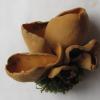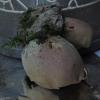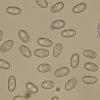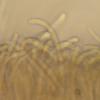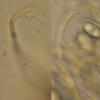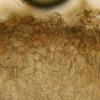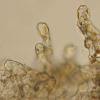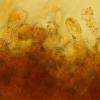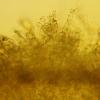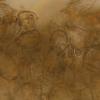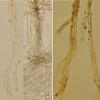
24-12-2025 17:08
Hulda Caroline HolteHello, I have found this propoloid ascomycete on

21-12-2025 09:32
Hello.A tiny ascomycete found embedded in wood in

21-12-2025 21:32
Pol DebaenstHello, Garden, Burgweg 19, Veurne, BelgiumOn 10/1

22-12-2025 23:38
Patrice TANCHAUDBonsoir, récolte sur un mur en pierre, apothéci

22-12-2025 00:47
Patrice TANCHAUDBonsoir, récolte à proximité du milieu dunaire
Otidea sp.
Viktorie Halasu,
29-11-2016 18:39
 Good evening,
Good evening,I'd like to ask for your help with this Otidea:
Found a few meters from Otidea concinna, on argillaceous ground, only deciduous trees around, 250 m.
Apothecia cupulate with a split, about 4 cm wide, hymenium lively ochre-yellow, receptacle more dull ochre. When fresh, it had a sweet (almond-like) smell. When drying, a purplish hue appeared on the receptacular surface for some time.
Spores ellipsoid, sometimes a bit inequilateral, 9,3-10,5 (11) × 5,3-5,8 um, Q = 1,7-1,9, with two LBs (sporeprint in water).
Paraphyses up to 4 um wide, bent to curved, usually equally wide all along, some a bit enlargened (up to 6 um) and with shallow notch(es).
Excipulum with yellow-brown exsudate. In MLZ discolors to reddish-brown, doesn't dissolve, no amber drops nor red particles observed. In KOH turns lemon yellow and dissolves into the medium - this is easily seen even with naked eye, like Mollisia rosae.
Mycelium very light brown in exsiccate, hyphae brownish with abundant yellow-brown exsudate. In MLZ stains more golden-brown to reddish-brown without dissolving. KOH reaction same as with excipulum, bright lemon yellow.
Unfortunately there's no photo in fresh state, the one here is already drying and a bit darker. The closest match I found was O. flavidobrunneola, but the apothecium colors are perhaps to dark for that species. Is there any other possibility?
Thank you in advance.
Viktorie
Jason Karakehian,
30-11-2016 03:07
Re : Otidea sp.
Hi Viktorie, there is a recent monograph of Otidea in Persoonia. 2015 Dec; 35: 166–229 by I. Olariaga, et al. I wonder if you have seen this? Best - Jason
Viktorie Halasu,
30-11-2016 08:08

Re : Otidea sp.
Hello Jason,
yes, sure, the key there lead me to O. flavidobrunneola, but it's not completely matching the description. Given the KOH reaction, this collection belongs to the O. concinna clade. Apothecium color can darken with age, so I could consider it a secondary character only. I don't know, how much variable can be the spore size and shape within Otidea, given that O. kauffmanii (Q = 2) is synonymized with O. rainierensis (Q = 1,7, same spore length, but barely overlapping width). As for this collections, mean spore dimensions are 10,4 × 5,7 um (living spores floating around apothecium section in water, maybe not all of them mature) or 9,9 × 5,5 um (sporeprint in water), mean Q = 1,8 in both cases.
Lack of amber drops in excipulum excludes O. minor, oregonensis and concinna. Lack of ribs/veins on receptacle surface excludes O. phlebophora and minor. Deeply cup-shaped apothecia exclude O. borealis. I don't think the exudate in mycelium dissolved in MLZ (as noted for both caeruleopruinosa and flavidobrunneola) but I will check that again to make sure. Perhaps Otidea sp. 'a' could be another possibility - spore size is overlapping and it lacks the bright yellow apothecium colors. But unfortunately they didn't describe it more.
yes, sure, the key there lead me to O. flavidobrunneola, but it's not completely matching the description. Given the KOH reaction, this collection belongs to the O. concinna clade. Apothecium color can darken with age, so I could consider it a secondary character only. I don't know, how much variable can be the spore size and shape within Otidea, given that O. kauffmanii (Q = 2) is synonymized with O. rainierensis (Q = 1,7, same spore length, but barely overlapping width). As for this collections, mean spore dimensions are 10,4 × 5,7 um (living spores floating around apothecium section in water, maybe not all of them mature) or 9,9 × 5,5 um (sporeprint in water), mean Q = 1,8 in both cases.
Lack of amber drops in excipulum excludes O. minor, oregonensis and concinna. Lack of ribs/veins on receptacle surface excludes O. phlebophora and minor. Deeply cup-shaped apothecia exclude O. borealis. I don't think the exudate in mycelium dissolved in MLZ (as noted for both caeruleopruinosa and flavidobrunneola) but I will check that again to make sure. Perhaps Otidea sp. 'a' could be another possibility - spore size is overlapping and it lacks the bright yellow apothecium colors. But unfortunately they didn't describe it more.
Nicolas VAN VOOREN,
01-12-2016 08:00

Re : Otidea sp.
Dear Viktorie,
this is not O. flavidobrunneola. But it seems there are two different species on your macrographs... Maybe this is due to an artefact!
For the first picture, you should look at the small-spored species with a strong furfuraceous outer surface, i.e. O. nannfeldtii, O. tuomikoskii, and O. papillata. In my opinion, the first one is a good option.
Nicolas
this is not O. flavidobrunneola. But it seems there are two different species on your macrographs... Maybe this is due to an artefact!
For the first picture, you should look at the small-spored species with a strong furfuraceous outer surface, i.e. O. nannfeldtii, O. tuomikoskii, and O. papillata. In my opinion, the first one is a good option.
Nicolas
Viktorie Halasu,
01-12-2016 10:19

Re : Otidea sp.
Hello Nicolas,
that's the same group of fruibodies on both photos, the second = the first seen from the left side. But I took the second with worse camera and wrong white balance, thats why the color doesn't match. I saw the purplish color myself, just made a bad photo of it.
I checked the species you wrote, but they all have a different reaction of exudate on KOH. It was really lemon yellow.
that's the same group of fruibodies on both photos, the second = the first seen from the left side. But I took the second with worse camera and wrong white balance, thats why the color doesn't match. I saw the purplish color myself, just made a bad photo of it.
I checked the species you wrote, but they all have a different reaction of exudate on KOH. It was really lemon yellow.
Viktorie Halasu,
02-12-2016 00:27

Re : Otidea sp.
Update on the ecology: only deciduous trees around. There used to be spruces and pines too, but not in the last ca. 10 years.
Ibai Olariaga Ibarguren,
02-12-2016 14:18
Re : Otidea sp.
Hi all,
My guess is that it is O. flavidobrunneola. The only fresh material I have seen, published in the monograph, was much paler, but the dried type specimen of O. flavidobrunneola reminds very much of your apothecia in colour. The distinct yellow reaction of the crystals on the ectal excipulum and the basal tomentum hyphae are characteristic as well.
Not always easy to distinguish O. caeruleopruinosa and O. flavidobrunneola. Based on the examination of their respective type collections and further material of both, the spore size seems to differ between O. flavidobrunneola and O. caeruleopruinosa. Your measurements would fit within O. flavidobrunneola.
Cheers,
Ibai.
Viktorie Halasu,
02-12-2016 21:33

Re : Otidea sp.
Hello, Mr. Olariaga,
thank you for the good news! This collection is from nordeastern part of the Czech Republic. I'll try to find it again next year and take some photos in situ.
There is also a possibility that I could have it sequenced next year. Which parts of the DNA would be sufficient - ITS and EF-alpha?
Kind regards,
Viktorie
thank you for the good news! This collection is from nordeastern part of the Czech Republic. I'll try to find it again next year and take some photos in situ.
There is also a possibility that I could have it sequenced next year. Which parts of the DNA would be sufficient - ITS and EF-alpha?
Kind regards,
Viktorie
Nicolas VAN VOOREN,
03-12-2016 11:44

Re : Otidea sp.
Thanks Ibai for your diagnostic, it was a big challenge to recognize it with the macrographs. But the microscopic characters agree.
Viktorie it will be great if you can find it again and photograph some specimens in situ.
About the DNA sequencing, ITS and LSU are useful.
Viktorie it will be great if you can find it again and photograph some specimens in situ.
About the DNA sequencing, ITS and LSU are useful.
Viktorie Halasu,
31-12-2016 23:23

Re : Otidea sp.
Just an update: BLAST search of its LSU sequence showed 99% match with the three O.flavidobrunneola collections used in the monograph, next is O. umbrina with 97%. ITS was not done yet.
Nicolas VAN VOOREN,
03-01-2017 21:06

Re : Otidea sp.
Thanks for your feedback.
